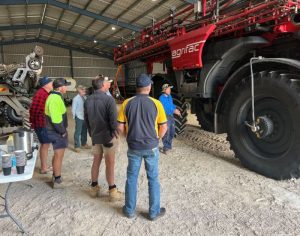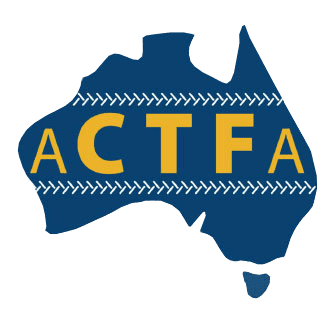IMAGE Courtesy Matt Pedersen, Australian Tyre Traders: Discussing the adjustments required on the track renovator to leave a better finish at Nhill Wheel Track Management Field Day.
The recent wet season across much of the eastern grain belt has generated a deal of interest in wheel track renovation from CTF farmers.
Growers at two ACTFA field days at Nhill and Horsham, Victoria, spoke about “porpoise” ruts that go up and down in the direction of travel along the wheel track and “ruts” that form in puddles where the soil is squeezed up and out of the wheel track. Track renovators have been designed for different conditions so it is important to choose one that suits the situation and adjust and/or modify it as required. The soils at the field day farms were heavy clays.
The field days included a live demonstration of the Knuckey Controlled Traffic Manager and paddock inspections of the wheel tracks renovated by the TPOS Flatrac, Grizzly Wheel Track Renovator and a set of 4.5m wide offset discs.
Re-firming the track is a key part of the renovation process. Some renovators have good packing systems (e.g. Knuckey CT Manager, TPOS Flatrac) whereas others (e.g. Grizzly) pack the track in another operation. Farmer experience suggests good packing is achieved by running over the track after rain using a wide tyre or a tracked machine about 600 mm wide. Renovators currently on the market are designed for track widths of about 700 mm. Knuckey have been building machines with capacity to renovate tracks up to 1.2m wide.
Sometimes 2-3 passes are needed to renovate the tracks. Ideal conditions for renovating are a little soil moisture and stubble to pack and make a brick “road”.
Other aspects of CTF and track management discussed by the groups included managing tyre pressures on the go with central tyre inflation systems, tyre types, how to match machinery CTF without breaking the bank, and integrating CTF with livestock. Further information on wheel track renovation is available at Permanent tramlines in CTF systems need maintenance | Groundcover (grdc.com.au) and check out this Twitter video of the Nhill field day.
The field days at Nhill and Horsham were an ideal opportunity to mix experience and curiosity, with some of those present having operated CTF systems in excess of 20 years (one almost 30 years) while others are just contemplating making a start.

Tim Rethus discussing how the central tyre inflation system on his Agrifrac sprayer adjusts tyre pressure on the go. Source: Katherine Colbery, PinG
Two challenges seen by participants at Nhill to the adoption of CTF were the expense of change and the difficulties of integrating livestock. These myths were busted by the CTF farmers present. They said it didn’t cost them any extra because they upgraded machines in line with their machinery upgrade plan and selected machines that suited their CTF system. Upgrading machinery in line with normal upgrade plans means it may take some time to achieve full CTF but over time you will get there. Those same CTF farmers also successfully run livestock as part of their system.
The field days were hosted by ACTFA and Partners in Grain and were an activity of ACTFA’s National Landcare Program Smart Farms Project 4-EALL5X “Resilient mixed farming systems in Victoria and New South Wales through controlled traffic farming. A workshop Series”.
Thank you very much to Bindi Isbister, Department of Primary Industries and Regional Development WA for facilitating the day, the field day hosts Alan Bennett, Nhill, and Tim Rethus, Horsham, and Knuckey Aus and TPOS Fabrications for their contribution to the days.

